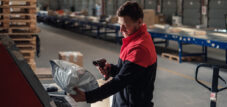[In collaboration with Kardex Remstar – ADVERTISING]
Increase efficiency and save costs
In times of constantly increasing competition and the resulting pressure to rationalize, the processes in intralogistics are also constantly being put to the test. No matter how expensive new purchases may be and even though conventional shelving systems could still work well for a few years, investing in automated storage systems enables the desired increase in productivity. The purchase of software-controlled carousel warehouses or storage lifts leads to savings in some of the core areas of the warehouse and thus reduces the cost pressure on the segment:
- labour costs
- Building costs
- Picking costs
- illness-related costs
- costs generated by mistakes
Added to this are the synergy effects that can be achieved by using the new machines in the warehouse.
1. Reduction in labor costs
- For this purpose, optical signals or displays integrated into the devices (pick by light systems) support the staff with regard to the location and number of items to be picked.
- Individual orders are also processed together (batch picking), which further increases speed.
Combined, the three methods significantly optimize the use of human labor and lead to productivity increases of 200 to 600 percent. In addition, with the help of the new technology, fewer employees more orders, which means that the remaining workers can take on other tasks in the warehouse or elsewhere in the company.
2. Reduction in space costs
Due to their modular design, vertical lift systems can be precisely adapted to the specified room heights in the warehouse. Compared to conventional shelving, they are taller and save space for aisles that would otherwise be reserved for staff or transport trolleys. This principle enables the required storage space to be reduced by up to 85 percent. In addition, the shelves of the storage systems can be prepared by installing special compartments or shelves in such a way that the largest possible number of items can be stored in them, which further reduces the storage space required per item. Instead of using the entire space for the traditional warehouse, the additional space can be used either to expand capacity or for other uses such as setting up a workshop or expanding production. This also eliminates the need to move to larger premises due to increased storage space requirements.
3. Reducing access costs
The incoming orders are reorganized and released for processing under software control. Individual items from the various orders are combined. For example, if a specific item is requested in several orders, the individual items are added together and the item is only retrieved from the warehouse once. This article is later added to the individual orders from a buffer warehouse located at the workplace. This batch picking (already mentioned under point 1) leads to a significant increase in the number of orders processed, as all the unnecessary travel and preparation times for searching, removing and collecting the items are eliminated
- A automatically and
- B only have to be done once
Production or customer orders can be fulfilled much more quickly, which not only helps reduce costs by saving time, but also increases satisfaction in downstream areas due to accelerated processing.
4. Reduction in sickness-related absence costs
The dynamic delivery systems attach great importance to ergonomics in the workplace. goods-to-person they practice not only saves staff time-consuming and sometimes arduous walking distances - with conventional storage solutions, it is not uncommon for employees to travel fifteen kilometers or more in one shift. In addition, the items are made available directly to the workplace via the removal openings in the devices in the ergonomically favorable area at waist height.
This eliminates bending or stretching movements that are prone to injury - especially with heavy parts - and thus one of the main causes of inability to work: injuries or signs of wear and tear in the human musculoskeletal system. This means that sickness-related costs due to absences are reduced and the insurance premiums for occupational safety benefits are also reduced as a result of the measures.
5. Reduction costs of incorrect access
Wrong picks are doubly expensive: On the one hand, there are the costs that arise for incorrect picking and forwarding, or picking and shipping of the intact item. However, there are also the expenses for reintegrating and picking the correct item again, for online retailers plus the return shipping, if necessary testing and cleaning as well as sending the goods again. All in all, this adds up to amounts that have an extremely negative impact on productivity given the comparatively high error rate of conventional storage solutions.
In contrast, software-controlled storage and retrieval systems achieve an accuracy of almost one hundred percent in pick rates. Sophisticated warehouse management software makes this possible while eliminating the natural rate of work errors by staff. The result is a result that saves the company costs with every mistake that is avoided.
6. Synergy effects
The warehouse management software that controls the new devices can be easily combined with the existing shelving systems, so that their interaction can also increase their efficiency. A smooth connection between old and new devices is of course possible. An advantageous solution, as it relieves the investing company of the pressure of having to replace all of its storage technology in one go. Instead, this process can be extended as desired and, for example, a decision can be made about further investments after a test phase.
Given the large number of cost and efficiency advantages described, it can be assumed that a further conversion from old to new will later be seen as a logical step. In addition, the return on investment occurs on average after just one to two years across all industries.

